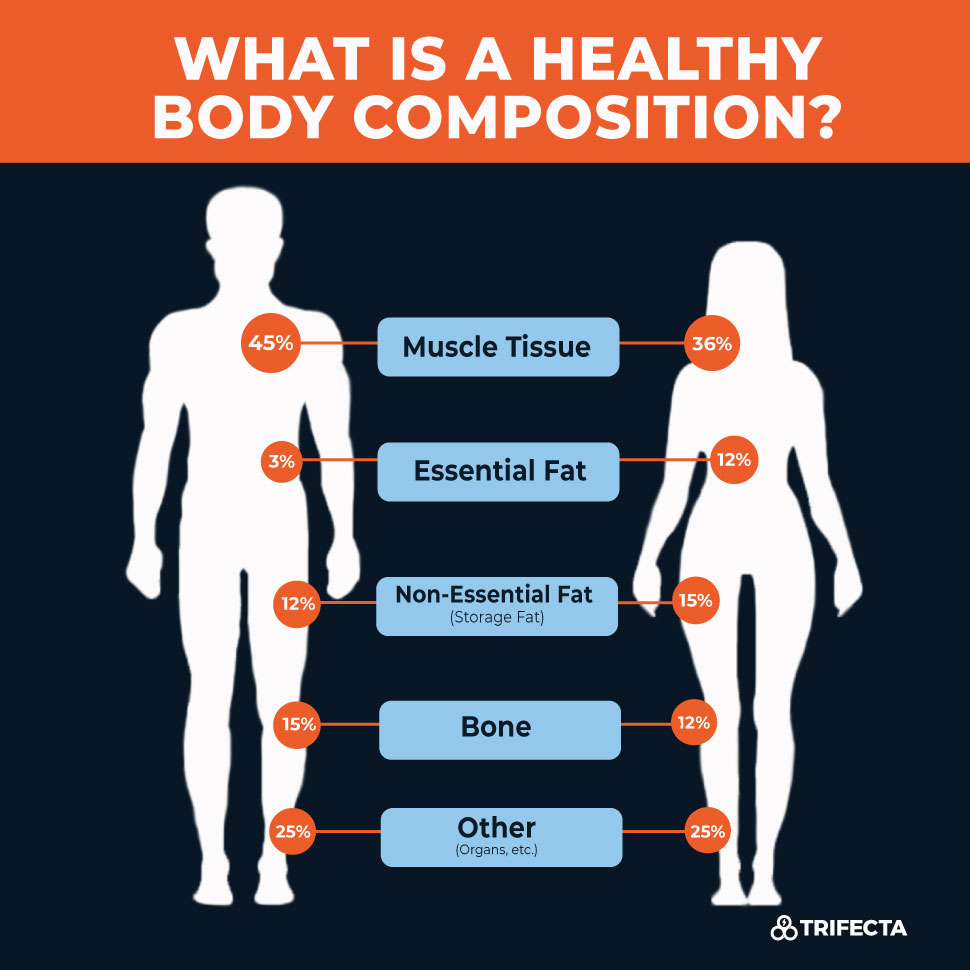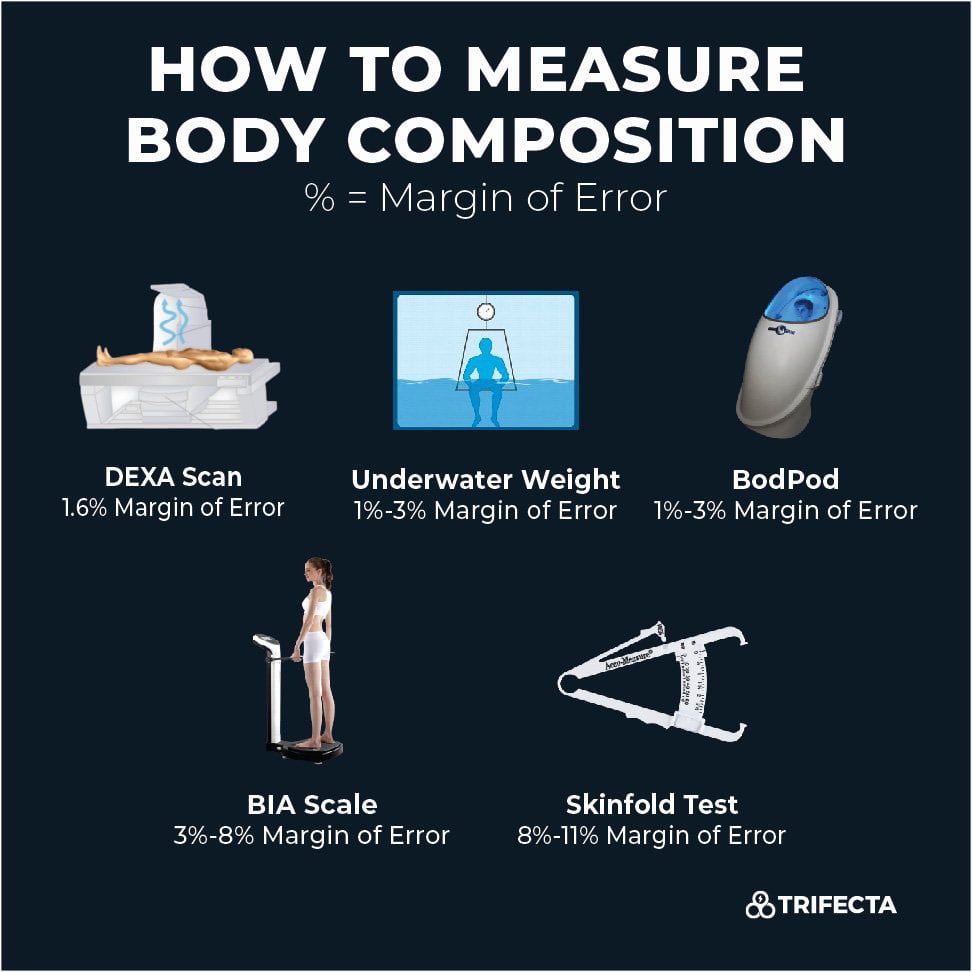Your body weight is only one measurement of your overall health and not always the end all be all. You should also be focusing on your body composition by identifying exactly where that weight is coming from. A body composition test will not only tell you your body fat percentage but can also help you fine-tune your nutrition needs for fat loss and muscle gain, and point out any health risks you might be facing.
Here’s your go-to guide for understanding what is body composition, how to measure body composition, and how to improve body composition.
What is Body Composition?
Body composition is the practice of breaking down the human body into its individual components including body fat mass, muscle mass, bone, tissue, and water. Body composition is essentially dissecting exactly what you’re made up of.
Undergoing body composition analysis can help you understand your body weight on a deeper level by telling you your body fat percentage, bone density, and lean muscle mass.
When someone says they want to improve their body composition or "recomp" (recomposition), it typically means they want to lose body fat and maintain or increase their lean body mass.

Why is Body Composition Important?
Body composition is the best way to tell if you are losing body fat or gaining muscle.
Oftentimes people on a weight loss plan will find that they aren’t losing weight early into their journey, which leads to frustration and giving up. This is common if you rely on the scale as the best way to measure weight loss. However, the scale is only one data point and doesn't give you the full picture.
Just because you aren't losing pounds doesn’t mean you aren’t losing fat. More often than not you are experiencing changes in water weight, or potentially gaining muscle and losing fat at the same time. This is where body composition testing comes in clutch.
The scale can tell you how much you weigh, but body composition tells you where that weight is coming from (aka fat, muscles, or bone).
Your body composition is also one of the best measurements of how physically fit you are and a predictor of increased risk for certain chronic diseases.
The higher your percentage of body fat, especially visceral fat that lines the organs in your abdomen, the greater your risk for developing nutrition-related chronic diseases such as metabolic syndrome, heart disease, obesity, and diabetes (1,2,3,4).
On the flip side, a higher lean body mass can often mean a better metabolism because muscle is more metabolic than fat and promotes a higher basal metabolic rate.
What is a Healthy Body Composition?
A healthy body composition depends on your gender, age, and fitness level. The "normal" range can also vary depending on the accuracy of the body composition assessment you choose. Generally speaking, you can use the following chart to assess your body composition status. Anything at or below average would be considered a healthy body fat percentage.
| Healthy Body Fat Percentage | ||
|
Description |
Male |
Female |
| Athlete | 6-13% | 14-20% |
| Fitness | 14-17% | 21-24% |
| Average | 18-24% | 25-31% |
| Above Average | >25% | >32% |
How to Measure Body Composition
There are five main body composition analysis tests on the market and each varies on the method and accuracy used. Here are five ways to measure your body composition and learn your body fat percentage.
1. Skinfold Tests
Skinfold tests are one of the oldest and most basic ways to measure the amount of body fat you have. Of course, because of the simplicity to this approach, it also tends to be the most inaccurate (r,r).
This method uses skinfold calipers to pinch the body in specific areas (chest, thigh, and abdomen) to measure the skinfold thickness. This can be done through a 3-point measurement or 7-point measurement that expands the test to other body parts including the triceps, below the armpit (Midaxillary), the shoulder blade (subscapular), and hip (suprailiac).
These measurements are then combined with a person's age and gender and input into a specific formula to provide a percent body fat estimate.
Skinfold tests are limited because it only measures subcutaneous fat (fat below the surface of the skin) and does not do a full body assessment. Not everyone stores fat in their body the exact same way. It is also subject to human error depending on who is performing the test.
You can get a skinfold test from many gyms or fitness centers and costs will vary.
2. Bioelectrical Impedance Analysis (BIA)
Bioelectrical Impedance Analysis (BIA) uses a low electric current that travels through the body to estimate fat free mass.
Since electricity can only travel through water, and each bodily tissue contains varying amounts of water, the flow of the electric current is impacted by the conductivity of each tissue type. For example, muscle holds more water than fat, so the flow of the current becomes less interrupted (low impedance) when a person has more lean mass and more interrupted (high impedance) when they have more body fat.
Then through a fairly standard algorithm/calculation the machine will then guess your body fat percentage.
Because of the way these tools function, hydration status can significantly impact the accuracy of the results. This also includes whether or not you’ve eaten or done any exercise before the test.
There are multiple types of BIA tools available on the market. Many are portable and extremely affordable, including bathroom scales and handheld machines. There are also more advanced BIA machines that use electrode placement on the body.
The margin of error for BIA body composition analysis is 3-8%, however this number is likely increased when using at home scales (5,6).
You can easily get an at home BIA scale or handheld machine for $30 to $50 and perform a body comp test any time you need.
3. Hydrostatic (Underwater) Weighing
Hydrostatic or underwater weighing is a form of densitometry that uses your body weight on land and in water, along with water displacement to estimate your body composition.
This method is based on Archimedes' principle, the buoyant force on a submerged object is equal to the weight of the fluid that is displaced by the object.
Muscle does not weigh more than fat, but it is denser and takes up less volume per pound.
In other words, muscle sinks and fat floats, so a person with more muscle mass will weigh more underwater than a person with a higher percentage body fat (7,8,9).
When performing underwater weighing, a person is required to expel all air from their lungs during the test, as any extra air will impact water displacement. The test is typically repeated three times and the average underwater weight is used.
To get a Hydrostatic body comp test look for fitness companies or online companies that have a traveling van or station on site to perform the test. It will run you about $35 to $50 a test.
This method is praised for being pretty accurate and has a margin of error around 1-3%.
4. Air displacement BodPod
Air displacement works similar to water displacement except an air controlled chamber resembling an egg-shaped pod is used. A BodPod uses a mechanical diaphragm to create small volume changes in a confined and controlled space and then measures pressure responses.
A person's weight, age, gender, and height are recorded before the test and the chamber is calibrated.
Then using the basic understanding, density equals mass over volume. A person’s mass is recorded with their body weight. Volume is measured using air displacement in the BodPod. Then since both fat mass and fat free mass have known densities, the BodPod can estimate how much fat mass and fat free mass a person has.
To get a BodPod test, you'll need to find a facility that will perform the test for you, and this is no easy feat. Most BodPods are found in medical or health facilities and are not widely available to the public. If you can find a fitness facility that offers them, they’ll run you about $40 to $50 a test.
The margin of error for BodPods is similar to underwater weighing at 1-3% (10).
5. DXA/DEXA Scan
A DXA or DEXA scan is the most accurate and advanced form of body composition analysis available.
It uses x-ray technology to scan your body and provides a detailed assessment of how much muscle mass and fat mass you have (down to the pound), and exactly where fat and muscle is stored on your body. For example, if your right arm has 0.5 more pounds of muscle than your left arm, a DEXA scan will identify this. This also means a DEXA scan will differentiate between subcutaneous and visceral fat. It can even tell you your bone density.
You can find many gyms that have DEXA machines on site or online companies that offer remote DEXA scans in a van, similar to hydrostatic weighing, and they will cost you about $50 a test.
The margin of error for a DXA/DEXA scan is 1.6% (11).
How to Improve Your Body Composition
Knowing your body composition is the first step in transforming your body and understanding your progress. If you’re just getting started on your weight loss or fitness journey, get a body composition test performed and use this as a benchmark moving forward.
Check back every 8 to 12 weeks (more frequently if using an at-home body composition scale) to see if your body fat percentage or muscle mass is changing. And then fine-tune your nutrition and fitness habits based on your body composition results.
Here’s how to do it:
Track Your Calorie Intake
Diet and exercise both play a key role in improving your body composition, with nutrition making the largest impact. If you want to lose body fat, learn your daily calorie goals and start tracking your intake.
If your goal is weight loss, you’ll need to continually decrease your calorie intake to lose body fat. But you don’t want to cut calories too low because you may end up losing muscle mass in the process. Not to mention, very low-calorie diets can be difficult to stick to and don’t set you up for long-term success.
If you want to gain weight, you’ll need to do the opposite and make sure you are eating a lot of additional calories to support muscle growth.
And if your goal is to maintain your weight and recap (change your body composition at your current weight), you’ll need to figure out how many calories you need to maintain your current weight and eat that amount.
Using a nutrition tracking app is one of the easiest ways to learn your calorie and macro goals, and to track your progress.
Learn Your Body Composition Macro Goals
While calorie control is crucial for changing your weight, your macro balance is critical for supporting your body composition goals.
If looking to lose weight, your goal is to lose more fat than muscle, and when gaining weight your goal is to gain more muscle mass than fat - and macros can help you achieve this.
Your unique macro requirements are dependent on your age, height, weight, gender, starting body composition, how much you exercise, and your individual health needs.
You’ll want to get enough protein to support your lean mass and potentially help you build some additional muscle mass. And adjust fat and carbohydrates according to the type and amount of exercise you engage in.
Once you know your goals, you can then track your daily macro intake using a nutrition tracking app to ensure you are staying on top of your nutrition needs.
You can easily get your daily macro goals using an online macro calculator or with a macro friendly tracking app.
Exercise to Build Muscle Mass
Exercise is not just to burn calories and fat, when looking to build or maintain muscle mass, the type of exercise you choose becomes pretty important. Just moving more can help you burn calories and lose body fat, but in order to build muscle you need to incorporate strength or resistance training.
Lifting weights is a great way to support your lean mass and help you burn fat. But if you’re new to this type of exercise, you can start with bodyweight movements or any type of exercise that challenges your muscles and builds strength.
Stay Consistent
Lastly, consistency is everything. Anyone can stick to a plan for a few weeks, but the real changes happen after months of consistency and hard work. Of course this doesn't mean that you need to change everything all at once or suffer to see changes in your body - its finding the small adjustments that work for you and continually working on improving.
Pick a small goal, like hitting your daily macros, and keep working on that one thing until you master it. Then reassess your goals to add new ones or fine tune existing ones as needed.
You also need to be patient and give your body time to see results. You cannot change your body composition in just a few weeks, it takes time and dedication. You get out what you put in, so hang in there and be patient. The body of your dreams is coming.
Want to make things easier on yourself? Get all of your nutrition taken care of with macro perfect meals cooked and shipped right to your door. Plus get free access to nutrition caching to help you achieve your body composition goals faster.





